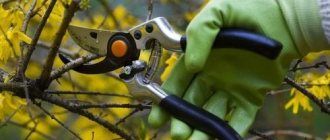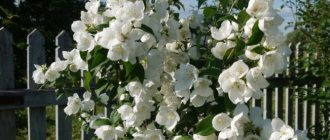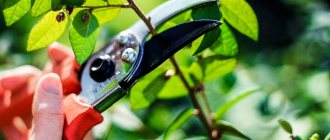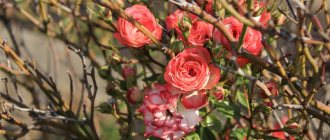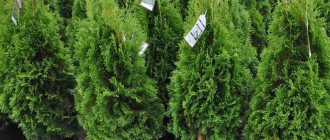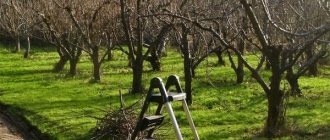Features of autumn care for thuja
The main measures for caring for ornamental plants in the autumn are aimed at strengthening the immune system and preparing for winter frosts. In order for the conifer to easily survive the winter, it must be provided with the correct agricultural technology.
Thuja watering regime in autumn
A crop planted in the autumn period requires irrigation measures and sprinkling in volumes equivalent to spring seedlings. A young plant is in great need of collecting a sufficient amount of moisture , which has a positive effect on overwintering. If there is a sufficient amount of precipitation in the fall, then watering should be reduced to almost a minimum or stopped completely.
Too much moisture, which affects the root system of a plant for a couple of weeks, often becomes the main cause of damage to the crop by pathogenic microflora or death.
Scheme and technology for pruning thuja in autumn
Pruning should be done only in dry weather. The above-ground part can be pruned into a pyramidal, columnar or spherical shape, and the Smaragd variety is most often used for spiral and chessboard garden figures. First, a careful inspection of the crown is carried out, and a visual determination of the desired shape of the above-ground part of the conifer is carried out.
You cannot trim branches immediately after rain, as in this case there is a risk of pests and various diseases appearing on the crown. To give an arched and rectangular shape, special blanks or twine are used. All tools used for pruning must be sharp and clean.
Rules for autumn feeding of thuja
There is absolutely no need to fertilize the plant immediately after planting it in a permanent place if all the appropriate fertilizing and fertilizers have been applied to the planting hole. The best option is to fertilize in spring or summer.
In areas characterized by poor soils, plants need to be fed with complete complex fertilizers. It is not recommended to feed plants in the autumn, since in this case there is an excessive development of shoots and branches that do not have time to fully form before the winter cold. Such conifers often die in severe frosts.
Frequency and timing of sanitary cleaning
Coniferous trees are cleaned 1-2 times a season. For most of them, spring cleaning is sufficient, but some breeds recommend cleaning in the fall in preparation for winter.
In the spring, work begins as soon as the temperature reaches above zero.
But you can clean the plant at the same time as sanitary pruning, especially if it has suffered from snowbreaker or sunburn. In this case, the timing is shifted to late spring, when the surviving buds on the shoots awaken and it will be clear which branches have died irrevocably and which will soon grow back.
Why is it better to remove dead needles in the spring? Most coniferous trees shed old and diseased needles at the end of September - October, and you may simply not have time to clean them before frost. In addition, dry needles serve as additional insulation and will help the trees overwinter more successfully.
Such a baby will never drop the needles on his own - he definitely needs help
Preparing thuja for winter
When preparing conifers for winter frosts, it is very important to adhere to standard deadlines, which vary depending on the soil characteristics and climatic conditions in the region where the ornamental conifers are grown.
How and when to cover thuja for the winter
Before deciding on the need to use shelter in winter, you need to decide on the age and time of planting of the conifer. If an ornamental plant was planted in the spring or summer of the current year, then it belongs to the category of young crops that need protection.
Mature and strong plants can easily do without shelter if they are planted in the shade of large trees or next to a house and a high fence. It is imperative to cover the above-ground part of the bush at temperatures below -35°C. To protect the crown, you should use light-colored, air-permeable, so-called “breathable” covering materials or traditional burlap.
Why and how to tie thuja in the fall
When preparing for winter snowfalls, the crown of young and adult thujas must be very carefully tied with nylon rope or twine, which will prevent the fluffy branches from breaking off under the weight of the snow mass. The crown of the conifer should not be tied too tightly , but a very weak tie is absolutely ineffective.
Preparing the thuja root system for wintering
The root system of the thuja, regardless of age, is characterized by compactness and a fairly superficial location. It is precisely because of their botanical characteristics that the roots of the conifer are capable of freezing out in winters that are too frosty and with little snow, as well as overheating in the hot summer.
To prevent freezing and overheating, it is necessary to carry out high-quality mulching of the soil in the autumn and spring. This agricultural technique also allows one to retain a sufficient amount of moisture in the surface layers of the soil, maintains the soil well in a loose state, and also prevents too active growth and development of weeds.
Digging and mulching tree trunk circles
Shallow digging and loosening followed by mulching of the soil can greatly facilitate the care of ornamental crops. Such activities must be carried out not only in early spring, but also with the onset of autumn.
A soil crust does not form under the mulch, and the soil itself receives effective protection from erosion during irrigation activities. Mulching can be done with garden compost, fallen leaves, lowland peat, wood chips and sawdust, as well as other organic components.
Watering
In the fall, it is important for thuja to carry out abundant moisture-replenishing watering, which ensures greater resistance of the plant to cold weather, since moist soil retains heat well and protects the roots from freezing. And also, thanks to a sufficient amount of water, the needles on the tree do not lose their rich color.
Moisture-charging watering of thuja
Moisture-charging irrigation is required even when rainy weather sets in. The exception is heavy rainfall for many hours. It is not recommended to introduce excess moisture in a clayey area or when planting thuja in low-lying areas where there is long-term stagnation of moisture.
The best time for watering is the last ten days of September or the first days of October. It is necessary to pour an average of 10 buckets of water under an adult plant. You can carry out this event over 3 days, evenly distributing the total amount of liquid. It is necessary to protect the trunk from water jets, so step back from it by about 20 cm when watering.
Autumn problems and methods for solving them
Failure to comply with cultivation technology and violations in the care regime often causes problems to appear in the autumn. A diseased plant may shed its needles or become very yellow.
How to prune thuja in the fall (video)
For what reason does the thuja shed its needles in the fall?
There are several reasons for needle drop, but the most common and easily identified include:
- too strong and prolonged frosts, which have an extremely negative impact on the appearance of the crown of not very frost-resistant varieties in the absence of high-quality insulation;
- severe drought in the autumn in the absence of high-quality freezing measures and drying out of the root system;
- sunburn, severely burning the youngest and most recently planted plants, in the absence of shading;
- too late and excessive application of chemical fertilizers, causing burns to the root system.
Among other things, ornamental crops can be affected by some diseases and plant parasites, including late blight, brown shoots, rust and schutte, thuja false scale, thuja moth, wireworm, thuja pine beetle and spider mite.
For what reason does the thuja turn yellow in the fall?
Natural browning of the conifer crown is often observed at the end of the growing season with the onset of late autumn. In this way, the plant adapts to the upcoming low temperature conditions. However, sometimes pronounced yellowing is the result of significant errors in care and violations of growing technology.
Therefore, it is strictly forbidden to carry out late autumn watering and transplanting , as well as planting seedlings in sunny areas without using a shading cover. Significant yellowing of needles can also be caused by excessive late application of fertilizers and insufficient oxygen supplied to the root system of the ornamental crop.
If the yellowing of the needles is caused by fungal infections, then it is advisable to perform preventive treatment of the crown with zircon or any copper-containing preparations, including HOM and Bordeaux mixture. Spraying tree trunk circles with a solution based on foundationazole, as well as spraying the crown with Tornado Antiklesch, have very high results. Also, in the fall, quite often, experts recommend using the drug “Decis”.
Preventative treatment
To protect thuja from outbreaks of dangerous diseases (rust or coniferous disease), it is important to spray the trees with suitable preparations in the autumn season.
Just like other plants, thuja requires preventive treatment
Choose a dry day around the beginning of November. They use “Ordan”, “Oksikhom”, “Abiga-pik”. You can prepare Bordeaux mixture (1%) liquid. It is important that when irrigating, the working solution completely covers the trunk, branches, needles, as well as the surface of the soil in the root zone.
It is necessary to protect the decorative thuja from the possible appearance of harmful insects next season. Pseudoscale insects, mealybugs, and sawflies are especially dangerous. The plant is often damaged by scale insects and thuja aphids.
For prevention, in the middle and last ten days of October, plants are irrigated with effective insecticides, using Inta Vir, Aktara, and Profilaktin. You can use Fufanon-Nova, Movento Energy, Alatar.
Why does thuja bark crack in autumn?
Breaks in the bark occur during the process of active growth of the cambium, which is located between the conifer bark and the wood. Through cracks formed in the bark, viral and fungal infections enter the wood, which can quickly cause the death of an ornamental crop.
To restore the health of the plant, you need to completely stop applying complex fertilizers and growth accelerators, and also be sure to add monopotassium phosphate, or a mixture based on 15 g of potassium sulfate and 40 g of superphosphate, into the tree trunk circles, which will stop rapid growth processes. It is recommended to treat cracks in the bark with a solution consisting of 15 ml of fufanon and 50 g of Abiga-Pik, diluted in a bucket of warm water. At the final stage of treatment, the cracks are cleaned and covered with garden varnish.
Top dressing
After pruning the tree, thuja requires increased nutrition in order to go through the recovery period faster. This will allow the tree to strengthen before frost.
Many people don’t feed thuja, but in vain
In autumn, a nutrient mixture with a high concentration of potassium is used, which helps preserve the decorative appearance of the needles. It is convenient to use mineral complexes for growing conifers.
For example, “Florovit”, “Agricola”, “Bona Forte”, “Fertika”. Choose varieties where there is o.
Other types of fertilizers can be used:
- bone or phosphate meal - 200 g/m2;
- well-ripened compost or crushed peat - 4 kg/m2;
- ash - 700 g/m2.
Dry substances are scattered on the ground in a circle around the tree trunk. Then the fertilizer is incorporated into the soil, after which abundant watering is carried out.
Preparing fertilizer from ash
You can make an infusion from the ash. Take two glasses of sifted substance. Pour in 10 liters of settled water. After 3 days, feed the thuja.
Cleaning pine
Pine needles live for about two years and become lemon-yellow before they die. Usually in August or early September, some of the needles inside the crown begin to turn yellow. Don't be alarmed, this is normal.
During autumn and winter, most of the needles will fall off on their own. The rest should be removed in the spring.
Since new growth is formed only at the tip of the shoot, the needles should be removed, but not the branch itself. By removing the growth point from the end of the shoot, you will destroy the branch completely.
This type of pine in the fall is normal.
Landscaping project from Sad-dizain
